2025 February Fiber Picks
RADIANT FIBERS
January 23-March 15, 2025
The Clive Davis Gallery at NYU, 370 Jay Street, Brooklyn, NY, 11201
https://tisch.nyu.edu/clivedavisgallery.html
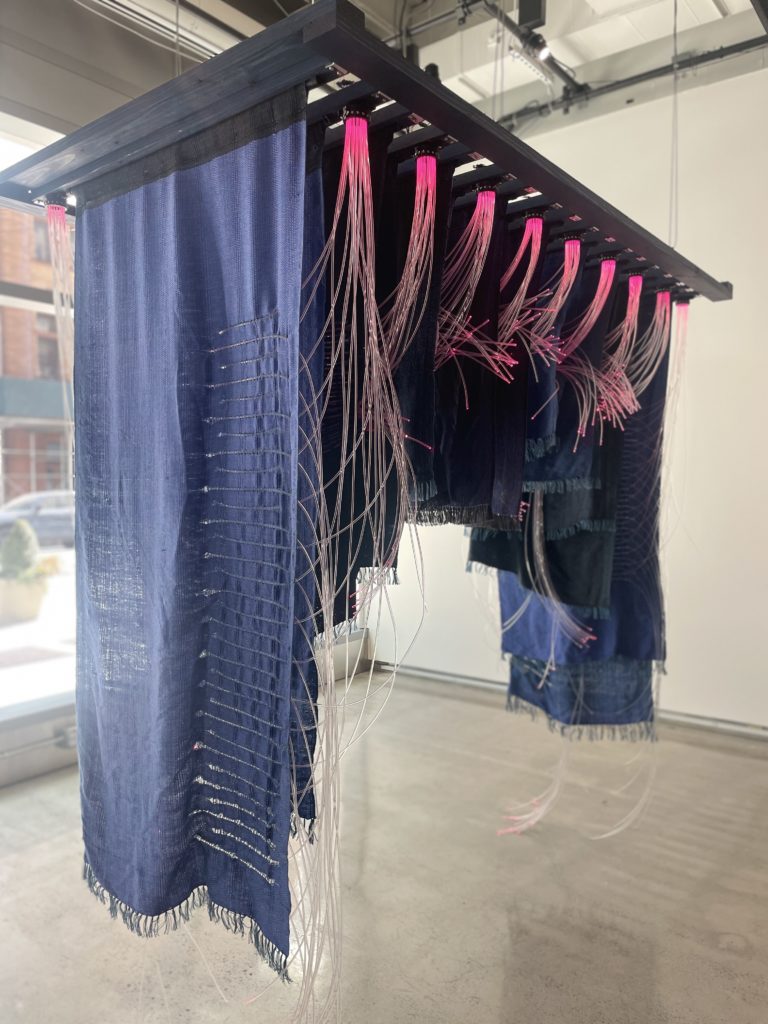
On view at NYU’s Clive Davis Gallery in downtown Brooklyn is Radiant Fibers, a group exhibition that explores the intersection of traditional methodologies from fiber arts with new technologies.
On the left, upon entering the gallery, is a large wall of smaller works by more than two dozen artists. At a glance, the objects look like stitch swatches from a weaving or knitting guide, except that many of them look like circuit boards or glow or incorporate wires interwoven and/or instead of yarn. Each intricate and totally unique, these hybrid textile-electronic pieces represent works created at the Electronic Textile Camp. This creative artist-run residency explores “the intersection of craft, computation, textiles, and electronics.” Ranging from soft sculptures and swatches to lamps and soundboards, these pieces successfully set the stage for what the exhibition challenges the viewer to consider—or, rather, forget—while moving through the show: that fiber’s traditional history in domestic arts is a limited perspective of a medium that, like paint, has unlimited faces and, when explored, can transcend.
Of the larger scale works, all experimental, a few themes emerged: combining the digital magic of coding with the tactile to make the digital physical; sculptures that, through the engagement and movement of the viewer, create ever-changing combinations; and technology as a storytelling tool. To me, all of this is so humanizing. Because I must admit—I was initially thrown by the term “eTextiles,” which appears in the wall text. I consider myself quite open-minded, but some things are sacred—“Keep your Internet off my textiles!” If any part of you agrees, I recommend you visit this exhibition and be surprisingly warmed by the beautiful, often mesmerizing works and the exciting alchemy of circuitry and textiles, algorithms and patterns, and logic-based languages and textures—because isn’t a pattern a technical language in itself?
And maybe I’m nieve to this thinking (correction: I am!), but isn’t it time we claim these digital materials for ourselves, as the digital world has surely claimed ours (think: fiber optics, fiber-based sensors, and carbon fibers not to mention the string-y nature of everyday wires and cables and tubings)?

Back to the art… Highlights of the show, aside from the fabulous wall at the top, are Liz Ensz’s “Anxiety Oracle (it’s easier to imagine the end of the world),” (2025) and Craftwork’s (artists Victoria Manganiello and Nicole Yi Messier) “Algorithmic Textures,” an extremely technical, complex, and layered sculptural work that, fittingly, only lists one material for its creation: Software.
WORKS by DR. MYRAH BROWN GREEN
MY UNDERGROUND RAILROAD: THE JOURNEY CONTINUES
January 30-February 28, 2025
St. Joseph’s University, Alumni Room Gallery, 245 Clinton Avenue, Brooklyn, NY 11205
https://www.sjny.edu/brooklyn/student-life/council-for-the-arts
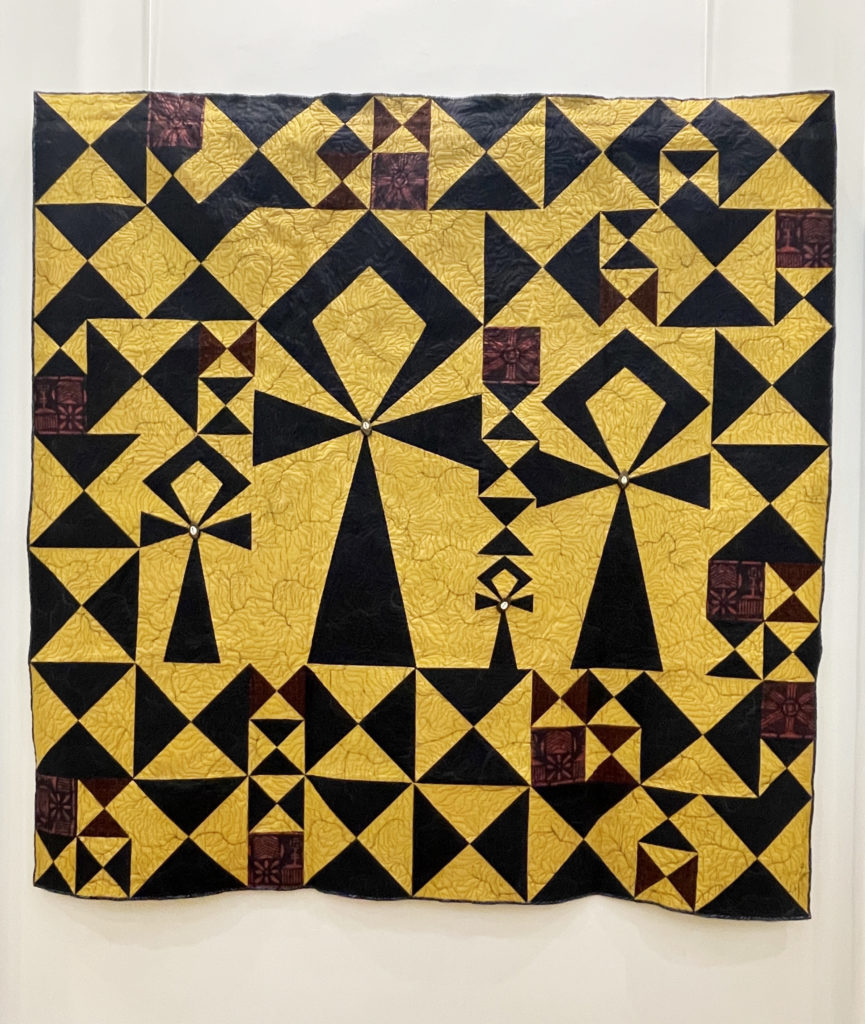
This winter, the Alumni Gallery at Saint Joseph's University has been hosting some excellent fiber shows, and the current exhibition of quilts by artist, curator, and art historian Dr. Myrah Brown Green is no exception.
Dr. Brown Green’s quilts each tell a story inspired by deeply listened-to stories shared by others and stories remembered from her own experiences. Further, through symbolism, a method she uses to communicate nonverbally, she investigates our collective stories—the stories that bind us together in this “shared universe.”
Traditional and hand-dyed fabrics, cowry shells and purls, large quilts and framed tapestries, and abstract, symbolic, and realistic works—this small exhibition shows Dr. Brown Green’s range and comes together as a whole through her use of color, repetition of materials, piecings, and free motion quilting. And the works are fabulous.
A stand-out is “a2 + b2 = c2: In Perpetuity,” which incorporates Egypt’s ancient ankh hieroglyphic (symbolizing life) and a topstitch pattern of palm fronds representing the protector/warrior Ogun, all composed as an exploration of Dr. Brown Green’s motherhood and self-dom.
CRAFT FRONT & CENTER: CONVERSATION PIECES
Ongoing
Museum of Arts and Design, 2 Columbus Circle, NYC, 10019
https://madmuseum.org/exhibition/craft-front-center-1
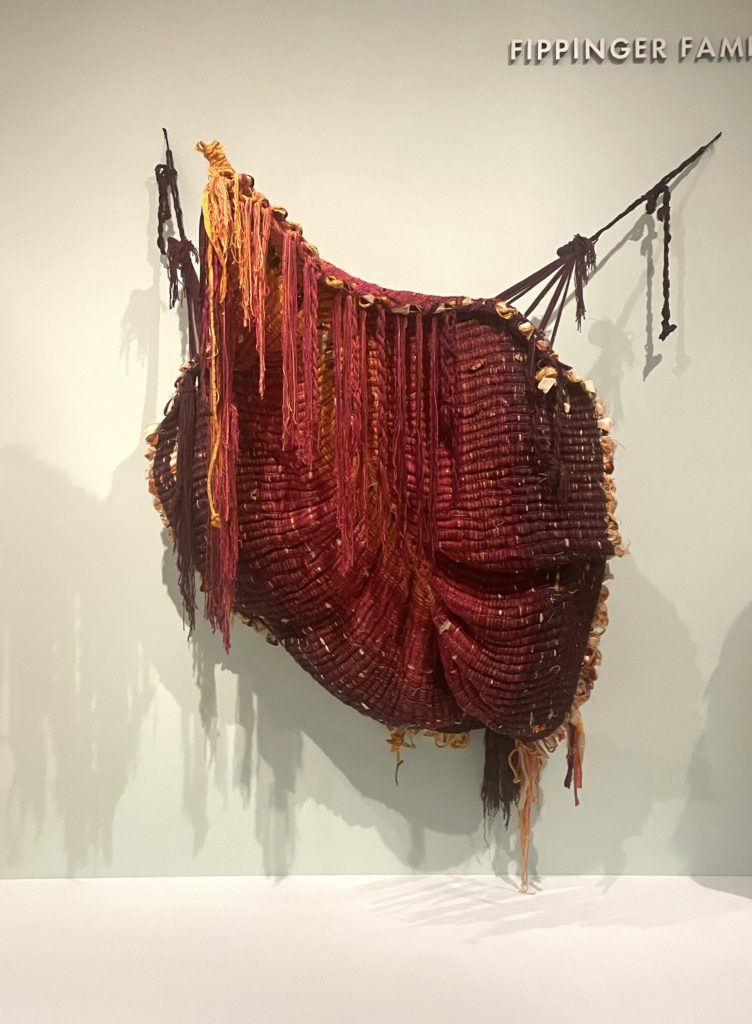
The concept of connection is foundational to the medium of textiles—tying a rope to a thread, knotting that thread to another thread or two, then braiding those together before weaving the ends into a tapestry stitched on top of a quilt. That sounds insane (and also pretty cool—if you decide to follow those instructions, please send a photo of the result), but you get the point: textiles connect.
But also, that textiles connect people and ideas is a concept so basic that our language is abundant with string-inspired tropes on the matter (e.g., “bind us together,” “loop me in,” “complex web,” “fabric of society,” ” and all-things “interlocked” or “intertwined”).
So banal is the language that it’s been a long time since I’ve reflected on my own textile experience. While I do connect things together, my textile work is extremely solitary—almost maddingly so.
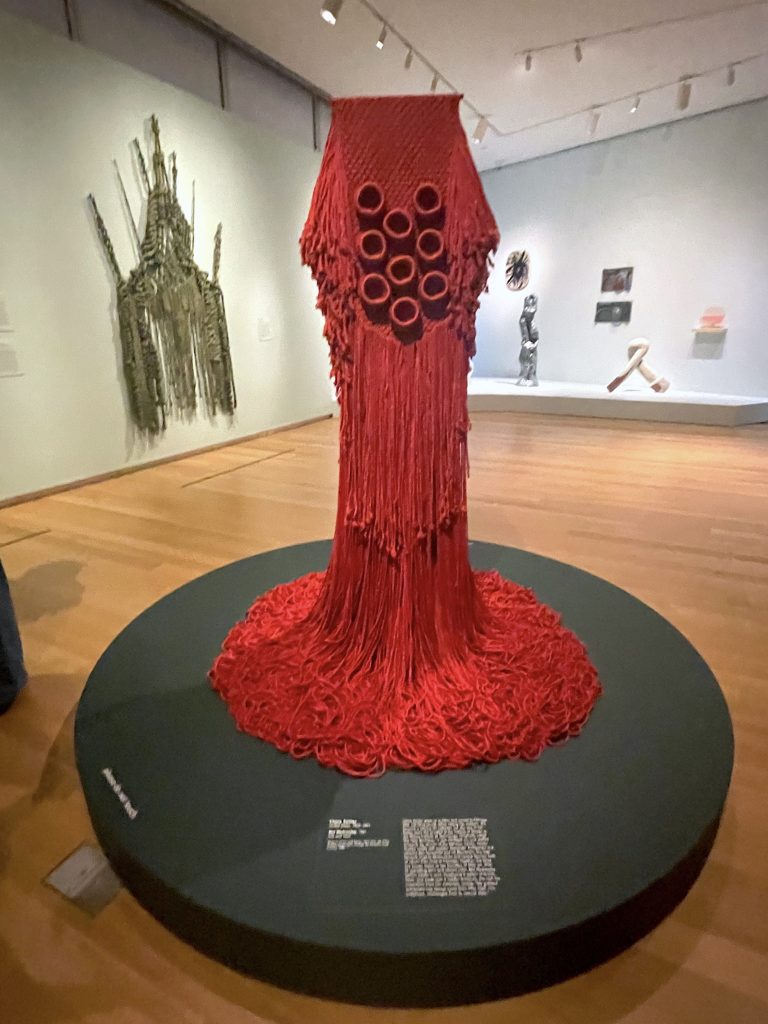
The Museum of Art and Design’s Conversation Pieces, too, digs a little deeper, exploring the literal “connections” of artists via teachers/students and mentors/mentees relationships, as well as their technical and visual influences/overlaps. In their striking approach, “connection” is supplanted with the word “conversation” and really kicks the reflection up a notch. In addition to thoughtful investigations, this exhibition offers a softer didactic approach for those easily overwhelmed by textile history (me). It’s a visual ORG chart—context that I find super helpful when trying to untangle layers of information (see—textile language everywhere!)
That said, totally separate from the exhibition’s concept and any art history endeavors, Conversation Piece is a feast for the art-lovers’ eyes. Culled from MAD’s permanent collection, this exhibition contains works by mostly midcentury fiber artists, but also some younger generations often working with found or unconventional materials and exploding sculptural structures—artists like Sheila Hicks, Claire Zeisler, Kira Dominguez Hultgren, Trude Guermonprez, and Kay Sekimachi.
And while you are at MAD, you should absolutely check out…
ANNE WILSON: The MAD Drawing Room and Errant Behaviors
Ongoing
Museum of Arts and Design, 2 Columbus Circle, NYC, 10019
https://madmuseum.org/exhibition/anne-wilson
https://www.annewilsonartist.com/mad-drawing-room-introduction/
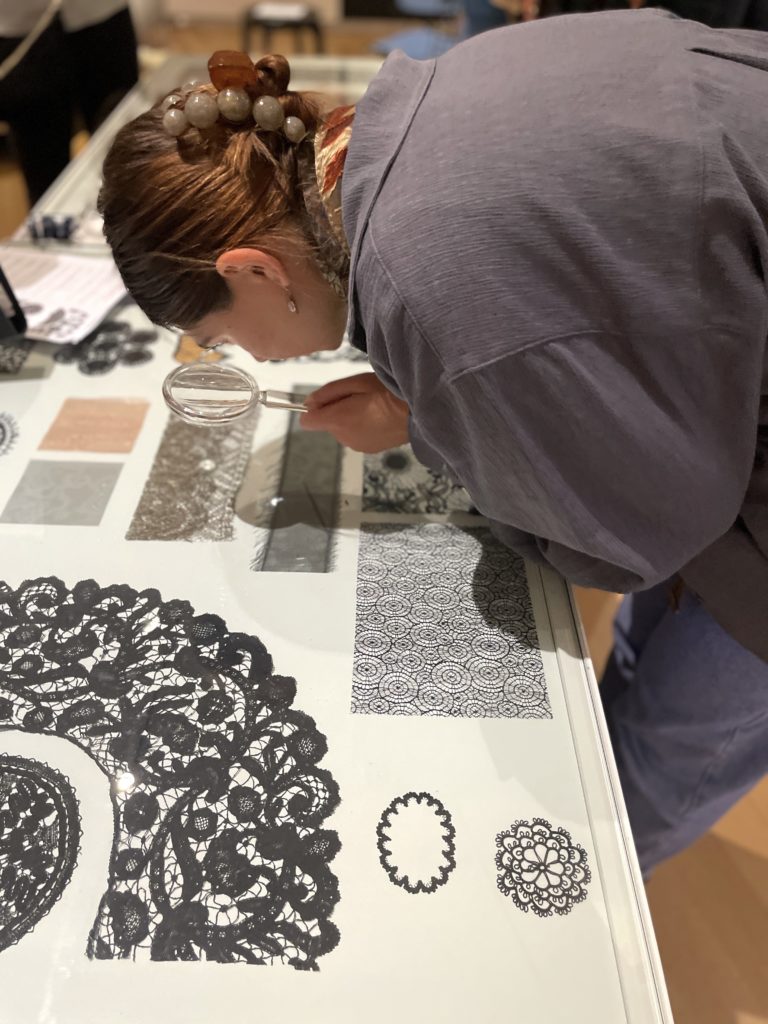
Within MAD’s Drawing Room, enclosed within eight long glass cases are hundreds and hundreds of “lace and openwork textile” swatches, all from the collection of artist Anne Wilson. The collection sources from Wilson’s piece Topologies, which was exhibited in the 2002 Whitney Biennial, but the evolution of the collection—bits of damaged lace fragments are her own, passed down, gifted, and found at flea markets and garage sales, if not dark then died dark for maximum visual effect—mimics the evolution of the project, which is layered indeed.
The compositions of the studies within the glass cases create a canvas of their own. Their singular visual elements stand alone, yet their pairings and interrelationships create a new layer of stories. What are these stories? This is part of the interactive work that the viewer is invited to explore.
The cases are set up with chairs, magnifying glasses, paper, and pencils and invite the viewer to look deeply at the pieces and engage with them on a personal level through several creative prompts outlined on a leaflet. One of the writing prompts invites the viewer to choose one fragment to study and ask several questions, including: Where is it from? When was it made? Who made it? “What technique was used? After, the viewer is invited to use the large binders in the gallery titled “Catalog of Identification of Lace and Openwork,” which give as much descriptive data about each piece as possible, to compare investigated theories against the available information cataloged.
Other prompts include drawing one swatch with as much detail as possible without a magnifying glass, inventing a new work by adding more pattern, color, or texture to an existing piece, and recreating a structure using continuous line drawing. Next to the reference library, also curated by Wilson, is a bulletin board inviting participants of the deep-looking exercises to pin up their work and share it with others.
Each of the 12-plus prompts can easily engross a museum-goer for hours. With my own limited attention span, what I found particularly useful was to take home the prompt sheet for later consideration with items and artwork and instead spend the hour or so within the gallery completely engrossed studying and mesmerized by the intricate array of studies—swatches stitched with human hair, laces so impossibly intricate they appear unreal, and synthetic fringes made seemingly without care but composed just so that they belong…in a museum.